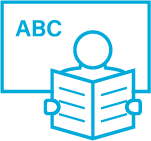Home Literacy Environments and Foundational Literacy Skills for Struggling and Nonstruggling Readers in Rural Early Elementary Schools
This study examined how home literacy environments might relate to rural kindergarten and first grade students’ reading performance. Home literacy activities and access to literacy materials were positively related to basic word reading skills, passage comprehension and spelling.
Authors: Ariel Tichnor-Wagner, Justin D. Garwood, Mary Bratsch-Hines & Lynne Vernon-Feagans
Source: Tichnor-Wagner, A., Garwood, J.D., Bratsch-Hines, M. & Vernon-Feagans, L. (2015). Home literacy environments and foundational literacy skills for struggling and nonstruggling readers in rural early elementary schools. Learning Disabilities Research & Practice, 31(1), 6–21, DOI: 10.1111/ldrp.12090
Factors such as weak early literacy skills and living in poverty may put young students at risk of reading disabilities. This study examined how home literacy environments might relate to rural kindergarten and first grade students’ reading performance. Parents of 1,108 kindergarten and first grade students in the rural Southeast United States completed questionnaires on the frequency of home literacy activities and access to literacy materials. Home literacy activities and access to literacy materials were positively related to basic word reading skills, passage comprehension and spelling.
- Research has found that factors such as weak early literacy skills and living in poverty may put young students at risk of reading disabilities.
- Good early reading instruction by classroom teachers in early elementary schools can be critical to helping many children learn how to read.
- Whitehurst and Lonigan (1998) conceptualised foundational reading skills that affect children’s later reading development in terms of two domains: 1) outside-in skills associated with reading comprehension, such as language, vocabulary, content and narrative understanding; and 2) inside-out skills focused on symbol/sound correspondences within words, such as word decoding, the alphabetic principle and phonemic awareness.
- Children’s home literacy environments have been found to influence both outside-in and inside-out language and literacy skills associated with later reading success.
- Poverty is the best predictor of children’s academic performance in school, including literacy development, and has been associated with weaker reading readiness in kindergarten and first grade.
- Rural children are exposed to many reading risk factors associated with geographic isolation, including limited access to libraries and other educational resources, the lower availability of high-quality preschool education and teachers who have fewer professional development opportunities, including less access to advanced degrees.
Literacy activities and materials in the home
- Frequency of reading to the child
- Teaching of letters
- Shared trips to the library
- Number of books in the home
- Helping the child with homework
- Listening to the child read
The study
In the current study, the types and frequency of literacy-related activities in the homes of rural kindergarten and first grade students were investigated, as well as the extent to which home literacy activities and access to literacy materials contributed to children’s outside-in and inside-out literacy skills.
Research questions
- To what extent do rural families with children in kindergarten and first grade engage in literacy activities in their homes? Do differences exist between children who were identified as struggling and nonstruggling readers?
- How do home literacy activities and access to literacy materials uniquely contribute to the basic word reading, reading comprehension and spelling scores of all students at the beginning of kindergarten or first grade, after controlling for demographic characteristics?
The data used in this study were drawn from a randomized controlled trial (RCT) prior to intervention implementation. The targeted reading intervention (TRI) was developed to help kindergarten and first grade struggling readers and their teachers in rural low-wealth schools by providing teachers with a weekly literacy coach, who used webcam technology to watch the teachers work with struggling readers and to give them real time feedback. Reading achievement data were available for 1,108 students (556 were struggling readers and 552 were nonstruggling readers).
Findings
- Struggling readers were more likely to be boys and Hispanic, come from homes with a lower family income and have mothers with fewer years of education than nonstruggling readers.
- Struggling readers had lower scores on letter-word identification (LW), word attack (WA) reading aloud, passage comprehension (PC) and spelling of sounds (SS) tests.
- Of the parents, 74.19% reported helping with homework between 5 and 7 days per week and 92.86% at least twice per week.
- Moreover, 42.98% of the parents reported supporting their children in learning to read between 5 and 7 days per week and 80.04% at least twice per week.
- In addition, 32.80% of parents reported reading to their children between 5 and 7 days per week and 74.04% at least twice per week.
- Nonstruggling readers were more likely to come from homes where someone read to them between five and seven days per week.
- Of the children, 68% lived in homes that had a computer, and 31% of parents reported having more than 50 books in their homes.
- Nonstruggling readers had more books in their homes and were more likely to have a computer in their homes.
- Of the families, 70% checked out books from the library for their children at least once a month.
- Grade, gender, maternal education and income, as well as access to literacy materials and home literacy activities, were significantly associated with students’ basic reading (LW and WA) scores.
- Grade, gender and income, as well as access to literacy materials and home literacy activities, were significantly related to students’ reading comprehension (PC) scores.
- Grade, gender and maternal education, as well as access to literacy materials and home literacy activities, were significantly related to students’ spelling performance (SS) scores.
Implications
- The results from the current study showed that rural families participated in a variety of literacy activities with their kindergarten and first grade children, and this was positively associated with outside-in (i.e. passage comprehension) and inside-out (i.e. letter identification, phonetic spelling) skills.
- Home literacy activities frequently took place in this sample of rural families.
- Considering that over half of the sample came from families with an annual income of less than $20,000, these findings combat negative stereotypes that cast low-income parents as being uninvolved with helping their children succeed in school.
- Rural kindergarten and first grade students had less access to print or digital reading materials when compared to national samples.
- Educators can provide parents with information to help children develop early literacy skills, including tips for how to help children with homework and engage their children in supplemental literacy activities.
- Teachers, for example, can provide details for parents on how to conduct storybook reading in ways that are aligned with school practices and that help build important early literacy skills (e.g. questions to ask to build comprehension, ways of pointing out aspects of the text to build print awareness, modelling fluency).
- Schools can ensure that they provide literacy resources to families with limited access; schools are an important avenue for providing access to computers and books.



